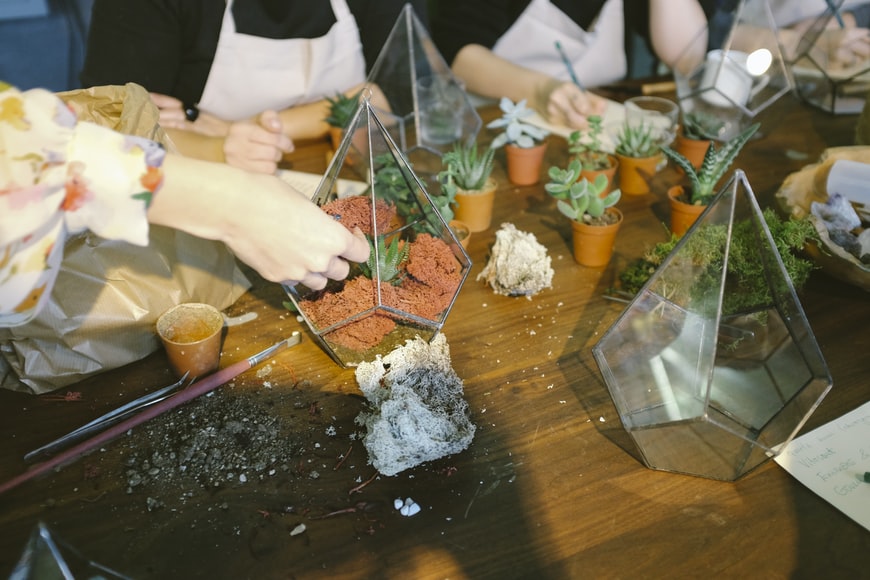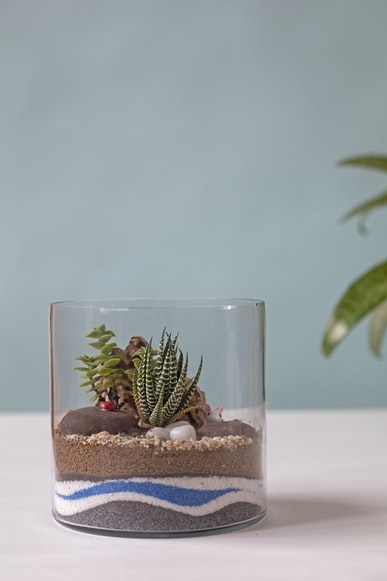Many people believe they are “wasting their time,” and they are frequently mistaken with leisure. Nevertheless, a hobby is a tool that helps enhance physical and mental health, stimulating and encouraging well-being, beyond being an activity that entertains and is done by vocation.
A pastime should be enjoyable without offending or irritating others. People adore Terrariums as a pastime, and many believe that it is now the healthiest activity available.
One of the most common worries among gardeners is a lack of space at home. However, given the resources they have, they can easily overcome this difficulty and enjoy producing plants. Terrarium gardening is an option for people who want to build a miniature garden without worrying about space.
Terrariums are miniature greenhouses for specific plants. The enclosure, generally constructed of glass, holds various plants that are occasionally combined with other components such as stones, wood, and other natural elements to create a miniature imitation of nature.
Terrarium Designing Details
| Category: Art, Crafts | Time: 1-2 hrs | Skill: Some |
| Initial Cost: $$$ (101-500) | Space: some | People: alone |
| Long-Term Cost: Low | Makes Money: Can, but not always | Location: indoor |
Who pursues this hobby?
Terrariums are popular among enthusiasts because they allow them to cultivate plants while expressing their creativity through the many designs available.
What truly brings it to life is converting a random collection of words into a book, developing a theme for your terrarium, and telling a tale with your composition.
Any (or all) of the terrarium’s elements can be used to create a theme.
Natural settings, such as the desert and the jungle, are arguably the most basic terrarium designs, but you can go much farther!
Benefits of designing terrariums
They help us to extend and enhance our talents while also allowing us to recognize our strengths.
- They allow us to “unplug” from stress and daily life.
- They are effective in the treatment of depression, anxiety, and uneasiness.
- They aid in the prevention of illnesses like Alzheimer’s.
- They promote self-control, innovation, and healthy competition.
- Assist with mental equilibrium and self-control.
- They are both cathartic and beneficial to one’s health.
- Enhance one’s social life and overall quality of life.
Terrarium as a pastime is a lovely endeavor in which one makes terrariums, sculptures, ponds, and a variety of other plants, garden, and park-related items.
Materials
With only a few inexpensive items, you can create a terrarium in no time. Simple terrariums may be made out of glass containers, mason jars, and even goldfish bowls, and small terrarium plants can be bought for a few dollars apiece.
- With or without a lid, a container with no drainage holes.
- Aquarium gravel or tiny crushed stone should be clean.
- Charcoal activated (found at a nursery or pet supply store)
- Plants for terrariums
- Sterile potting soil
- Moss on a sheet
- Elements of decoration
How to startup this hobby?
Half the joy of constructing a terrarium is picking out your container and plants. You may buy a variety of specialist terrarium containers, including ones that resemble tiny Victorian greenhouses or conservatories and cost hundreds of dollars.
Aquariums, goldfish bowls, cold frames, bell jars, tureens, apothecary jars, cloches, mason jars, glass cookie jars, and even big brandy snifters are all appropriate containers. A large aperture allows you to easily add drainage material, soil, plants, and ornamental items to the container.
Note that condensation and fungal plant diseases are less likely to occur in open terrariums than in closed ones.
In choosing plants, larger terrariums can accommodate larger houseplants, but fast-growing species or ones with huge leaves that obstruct light from smaller plants should be avoided.
Look for plants that grow in low to medium light when choosing terrarium plants. Choose a variety of leaf sizes, textures, and colors for aesthetic appeal.
Choose plants that will thrive in a terrarium’s naturally damp climate.
In an enclosed terrarium, avoid cactus and succulents; these plants thrive in empty pots filled with a potting mix containing lots of gritty sand.
In decorating the terrarium, you can use small figurines, shells, ornamental stones, or other whimsical embellishments scattered among the plants to adorn the inside of the terrarium if desired.
Water the plants using a spray bottle or a tiny watering container with a rose attachment on the spout to keep them moist but not dripping wet. Clean any debris sticking to the glass edges of your container with the spray bottle before wiping clean with a newspaper or a paper towel.
It would be best never to use glass cleaner inside a planted terrarium since it might damage the plants.
How to maintain your terrarium?
A terrarium is simple to maintain. Every few weeks, do the following three tasks:
Check to see whether the soil is dry and needs to be watered. Terrariums, both partially and fully enclosed, retain water for far longer than most potted houseplants.
Check for condensation in a closed terrarium. To improve ventilation, remove the top at least once a month. Remove the lid and leave it off until the moisture has subsided. If you use too much water, remove the terrarium top as well.
Remove any yellowing or broken leaves, and clip plants that have grown too large for the container.
Cost of terrarium designing
Terrariums provide a fantastic selection of ready-made terrariums and DIY terrarium kits for sale! Some of them have incredible details, even down to a bit of human inside the lush landscape. Some terrarium costs $200.
Terrariums are pretty inexpensive to construct. Depending on what creative supplies you already have, acquiring all of the elements for your terrariums won’t break the bank.
Is terrarium designing profitable?
Terrariums are one of the low-cost, low-maintenance products you may make in your house to resale when it comes to homemade décor. Terrariums are viable for aspiring hobbyists seeking a new concept or crafty artisans looking for a new revenue stream.
While selling online provides a global platform for you to sell your one-of-a-kind products, don’t overlook the possibility of selling in person.
Consider selling your miniature gardens at markets and fairs because terrariums are compact and portable. Setting up a market booth or pop-up shop helps small businesses test their products in front of the public and receive immediate feedback without paying exorbitant rental costs for a permanent location. Temporary retail sites also allow hobbyists to sell anywhere, at any time.
Conclusion
If you want to try out your green thumb but don’t have the space for large indoor plants, a rich, attractive terrarium might be a great alternative. Terrariums don’t take up much space and are simple to care for; they’re perfect for small space residents, novices, and busy plant parents. It’s also a fun activity to engage in, especially given the current epidemic, as well as stylish house décor.


